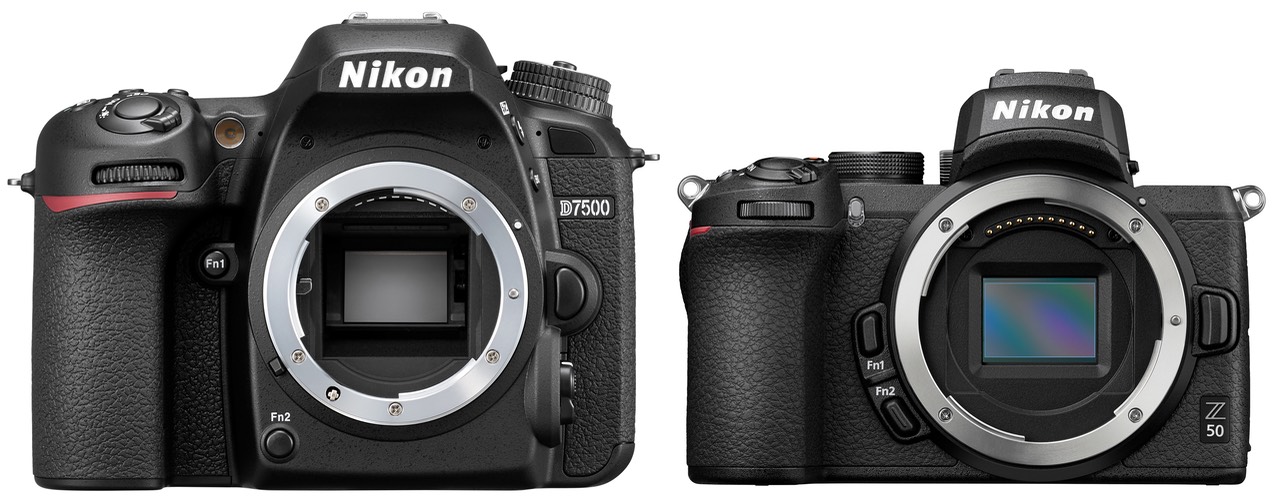
One of the topics that keeps coming up has to do with whether or not a mirrorless camera system saves any size and weight from the DSLR that a user might currently be using.
No matter what answer you're looking for, I can give it to you ;~). That's because we end up with a lot of apples-versus-oranges situations. Even what might look like an apples-to-apples comparison at first (e.g. 50mm f/1.8 lenses) turns out not to be, as the Z mirrorless lens so clearly outperforms the very best DSLR one Nikon has produced that you're no longer comparing equivalents.
So what to make of the question: are mirrorless Nikon Z systems smaller and lighter than equivalent Nikon DSLR systems?
Let's start with what should be an easy comparison, but isn't: a two-lens Z50 kit (US$1100) versus a two-lens D7500 kit (US$1200). While they use the same image sensor and thus final picture quality is essentially the same, the Z50 is a bit lower specified than the D7500. Also, the two-lens kit for the Z50 goes from 16 to 250mm while the DSLR two-lens kit goes from 18 to 300mm. Those differences aside, Nikon's pricing alone seems to suggest that these two kits should appeal to the same photographer, and I tend to agree.
- Z50 — 35 ounces (15.9 + 4.8 + 14.3)
- D7500 — 43.8 ounces (22.6 + 7 + 14.2)
So the DSLR kit is 25% heavier. The volume taken up by the Z50 kit is considerably lower, too. The Z50 camera body itself is narrower, shorter, and thinner than the D7500. I'll attest to the fact that my Z50 travel kit just packs much smaller than my equivalent D7500 kit.
So here I think the assessment is: given these two kits, the Z50 one is clearly smaller and lighter. The question then quickly becomes what are you giving up and what are you gaining in other ways? The Z50 kit is all VR, the D7500 kit Nikon sells isn't. The Z50 kit gets down to 24mm equivalent, a useful wide angle addition, while the D7500 kit gets to 300mm, a minimal telephoto addition. The D7500 shutter gets to 1/8000 and 1/250 flash sync, the Z50 only 1/4000 and 1/200. The list of non-equivalences goes on and on.
Thus, one of my theses is this: yes, basic comparisons between Nikon Z and DSLR kits tend to favor the Z for size, weight, and packability, but the DSLRs often tend to offer more performance and features.
Let's look at another comparison: the current 24-70mm f/2.8 lens with the Z7 or D850.
- Z7 — US$5100 (US$2800 + US$2300) and 52.2 ounces (23.8 + 28.4)
- D850 — US$4900 (US$3000 + US$1900) and 70.7 ounces (32.3 + 38.4)
The mirrorless version here is again clearly smaller and lighter, though now slightly more expensive. I'd also say that the S-line lens for the Z outperforms the F-mount DSLR version, and clearly so. But again, we get away from the apples and into the oranges pretty quickly (one slot versus two, again with the lower flash sync speed, and more). Still, we're arguably within my thesis (despite the better Z lens).
Where things get the most muddy is in the middle. We don't have as close an equivalent in the Z6/D780 typical lens options, which starts to distort sizes, weights, and prices.
So let's start with the bodies:
- Z6 — US$1800, 23.8 ounces
- D780 — US$2300, 29.6 ounces
Yes, there's a size and weight difference in the bodies. There's also a clear monetary advantage for mirrorless as I write this. Performance-wise, the Z6 and D780 are closer than any of the other mirrorless/DSLR matches to date.
It's the lens choices that start to make things messy for the middle. Consider these:
- Z6 lenses — 14-30mm f/4, 24-70mm f/4, 70-300mm f/4.5-5.6 AF-P on an FTZ (66.8 ounces)
- D780 lenses — 16-35mm f/4, 24-120mm f/4, 70-300mm f/4.5-5.6 AF-P (73.9 ounces)
We're not getting equivalent lenses to compare, except for the telephoto, and that requires an adapter on the Z6. And grand total we've saved maybe 10% in weight with the mirrorless choice. Is that enough weight loss for you?
We could pit primes against each other, at least at 20mm, 24mm, 35mm, 50mm, and 85mm. But there the Z lenses tend to be bigger and heavier, faster to focus, and optically superior, so again not really a good comparison.
Thus, there's really no good answer to the question in the headline, unfortunately. No matter which brand you attempt a comparison with (or multiple brands), you get tangled up in the same problem: there's no exact equivalence, so you'll have to figure out if you want apples or oranges.
Thus, the way I tend to phrase things to people who ask me if mirrorless is smaller and lighter is this: yes, it very much can be if you keep the comparison as close as possible but are willing to sacrifice some things in features and performance.
As many of you know, I've been using mirrorless cameras since 2009. I've had plenty of domestic and international trips over which to form some conclusions. For broad, general types of photography, such as travel photography, I long ago moved to smaller and lighter mirrorless kits. Ditto for hiking into the backcountry doing landscape photography. But to get to a truly lighter, smaller kit, I sometimes have to give something up and pay very careful attention to lens choices. For specific niche photography, such as sports or wildlife, I still tend to use DSLRs, and my backpack tends to be heavier and larger when I seek performance over all else.